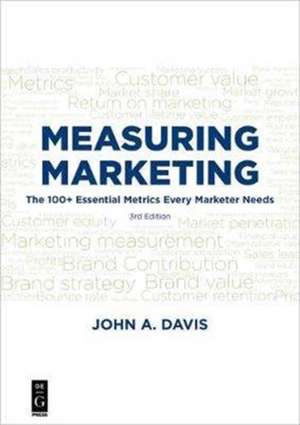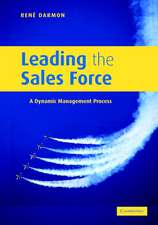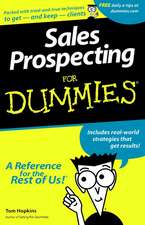Measuring Marketing
Autor John Davisen Limba Engleză Paperback – 19 dec 2017
Along the way, you'll be introduced to a variety of important analytical tools, from brand, customer, and sales metrics to advertising, price, and distributions metrics. And with the addition of new examples and metrics--including significant updates to the online/digital/social area-- Measuring Marketing, Third Edition will put you in a better position to excel at this difficult endeavor.
Preț: 305.56 lei
Nou
Puncte Express: 458
Preț estimativ în valută:
58.48€ • 60.82$ • 48.28£
58.48€ • 60.82$ • 48.28£
Carte disponibilă
Livrare economică 24 martie-07 aprilie
Preluare comenzi: 021 569.72.76
Specificații
ISBN-13: 9781501515767
ISBN-10: 1501515764
Pagini: 392
Ilustrații: 45 Schwarz-Weiß- Abbildungen, 25 Schwarz-Weiß- Tabellen
Dimensiuni: 170 x 240 x 22 mm
Greutate: 0.66 kg
Ediția:3rd edition
Editura: De Gruyter
ISBN-10: 1501515764
Pagini: 392
Ilustrații: 45 Schwarz-Weiß- Abbildungen, 25 Schwarz-Weiß- Tabellen
Dimensiuni: 170 x 240 x 22 mm
Greutate: 0.66 kg
Ediția:3rd edition
Editura: De Gruyter
Notă biografică
John A. Davis is Chairman of Brand New View LLC, USA. His career spans the academic and business worlds, as a senior executive and leader in both. He is the author of several acclaimed marketing books. John is a visiting professor at the International Olympic Academy in Olympia, Greece, and has also taught at University of Washington, UC Davis and Stanford University, and in partner programs with faculty from University of Chicago, INSEAD, Emory, Munich Business School, and the European Business School. John has also taught in dozens of executive education programs for leading companies, including: IBM, DOW Chemical, and Allianz. His research interests are in global brand leadership, marketing strategy, sports marketing, and marketing accountability. He received his M.B.A. from Columbia University and his B.A. from Stanford University.
Cuprins
Part 1: Corporate Financial Metrics ¿ 1
Chapter 1: Revenue ¿ 3
Chapter 2: Gross Profit ¿ 7
Chapter 3: Value-to-Volume Ratio ¿ 9
Chapter 4: Net Profit ¿ 13
Chapter 5: Earnings-Based Value ¿ 17
Chapter 6: Return on Sales ¿ 23
Chapter 7: Return on Assets ¿ 25
Chapter 8: Return on Equity ¿ 27
Part 2: Marketing Planning Measures ¿ 31
Chapter 9: Market Share ¿ 33
Chapter 10: Relative Market Share ¿ 35
Chapter 11: Market Growth ¿ 37
Chapter 12: Market Demand ¿ 39
Chapter 13: Market Penetration ¿ 41
Chapter 14: Program/Nonprogram Ratio ¿ 47
Chapter 15: Program/Payroll Ratio ¿ 49
Chapter 16: Causal Forecast ¿ 51
Chapter 17: Time Series Analysis ¿ 57
Part 3: Brand Metrics ¿ 63
Chapter 18: Brand Equity ¿ 65
Chapter 19: Brand Scorecards ¿ 71
Chapter 20: Brand Premium ¿ 75
Chapter 21: Brand Contribution and Review Analysis ¿ 81
Part 4: Customers Metrics ¿ 85
Chapter 22: Net Sales Contribution ¿ 91
Chapter 23: Time-Driven Activity-Based Costing ¿ 93
Chapter 24: Segment Profitability ¿ 95
Chapter 25: Customer Profitability ¿ 99
Chapter 26: Share of Customer ¿ 101
Chapter 27: Return on CustomerSM ¿ 105
Chapter 28: New Customer Gains ¿ 109
Chapter 29: Customer Acquisition Costs ¿ 113
Chapter 30: Cost Per Lead ¿ 117
Chapter 31: Retention Rate ¿ 121
Chapter 32: Churn Rate ¿ 125
Chapter 33: Consumer Franchise ¿ 129
Chapter 34: Customer Equity and Customer Lifetime Value ¿ 133
Chapter 35: Customer Brand Value ¿ 137
Chapter 36: Customer Losses ¿ 139
Part 5: Product/Offering Metrics ¿ 143
Chapter 37: Usage ¿ 145
Chapter 38: New Product Purchase Rate ¿ 147
Chapter 39: Marketing Cost Per Unit ¿ 151
Part 6: Price Matrics ¿ 153
Chapter 40: Price ¿ 155
Chapter 41: Mark-Up Pricing ¿ 159
Chapter 42: Target Return Pricing ¿ 163
Chapter 43: Sales Price Variance ¿ 165
Chapter 44: Markdown Goods Percentage ¿ 169
Chapter 45: Profit Impact ¿ 171
Part 7: Advertising/Promotion Metrics ¿ 175
Chapter 46: Share of Voice ¿ 177
Chapter 47: Recall ¿ 179
Chapter 48: Recognition ¿ 183
Chapter 49: Reach ¿ 185
Chapter 50: Frequency ¿ 187
Chapter 51: Gross Rating Points ¿ 189
Chapter 52: Cost Per Gross Rating Point ¿ 193
Chapter 53: Response Rate ¿ 195
Chapter 54: Conversion Rate ¿ 199
Chapter 55: Advertising-To-Sales Ratio ¿ 201
Chapter 56: Promotion Profit ¿ 203
Part 8: Direct Marketing Metrics ¿ 207
Chapter 57: Direct Marketing Revenue Goals ¿ 209
Chapter 58: Direct Marketing Profit Goals ¿ 213
Chapter 59: Direct Marketing Gross Profit ¿ 215
Chapter 60: Direct Marketing Net Profit ¿ 217
Chapter 61: Direct Marketing Return On Investment ¿ 219
Part 9: Digital/Social Metrics ¿ 221
Chapter 62: Gross Page Impressions (Or Gross Page Requests) ¿ 223
Chapter 63: Word of Mouth ¿ 225
Chapter 64: Total Clicks ¿ 1
Chapter 65: Click Through Rate ¿ 229
Chapter 66: Cost Per Click ¿ 231
Chapter 67: Cost Per Action ¿ 235
Chapter 68: Pay Per Lead ¿ 237
Chapter 69: Activity Ratio for Social Media ¿ 239
Chapter 70: Deductive Social Media Return on Investment ¿ 241
Chapter 71: Resolution Time ¿ 243
Chapter 72: Social Media Profitability ¿ 245
Chapter 73: Bounce Rate ¿ 247
Chapter 74: Return On Advertising Spend ¿ 249
Part 10: Place/Distribution Metrics ¿ 251
Chapter 75: Cost Per Sales Dollar ¿ 253
Chapter 76: Transactions Per Customer ¿ 255
Chapter 77: Transactions Per Hour ¿ 257
Chapter 78: Average Transaction Size ¿ 259
Chapter 79: Avergage Items Per Transaction ¿ 261
Chapter 80: Hourly Customer Traffic ¿ 265
Chapter 81: Returns to Net Sales ¿ 267
Chapter 82: Inventory Turnover ¿ 269
Chapter 83: Percent Inventory Carrying Costs ¿ 271
Chapter 84: Gross Margin Return on Inventory Investment ¿ 273
Chapter 85: Sales Per Square Foot ¿ 277
Chapter 86: Sales/Profits Per Employee ¿ 279
Chapter 87: Retail Close Ratio ¿ 281
Chapter 88: Retail Margin Percentage ¿ 285
Chapter 89: Percent Utilization of Discounts ¿ 287
Chapter 90: Shrinkage to Net Sales ¿ 289
Part 11: Sales Metrics
Chapter 91: Net Sales Contribution ¿ 297
Chapter 92: Absolute Index ¿ 299
Chapter 93: Relative Index ¿ 303
Chapter 94: Percent of Sales ¿ 305
Chapter 95: Independent Sales Representative Analysis ¿ 309
Chapter 96: Turnover Rate ¿ 311
Chapter 97: Recruiting ¿ 315
Chapter 98: Breakdown Approach ¿ 317
Chapter 99: Workload Approach ¿ 321
Chapter 100: Sales Performance Quotas ¿ 327
Chapter 101: Average Sales Per Call ¿ 335
Chapter 102: Close Process and Close Ratio ¿ 337
Chapter 103: Cost Per Call ¿ 341
Chapter 104: Break-Even Sales Volume ¿ 343
Chapter 105: Sales Productivity ¿ 347
Chapter 106: Four Factor Model ¿ 351
Chapter 107: Sales Variance Analysis ¿ 355
Chapter 108: Sales Volume Variance ¿ 361
Chapter 109: Sales Enablement ¿ 365
Chapter 110: Net Promoter ScoreR ¿ 367
Index
Chapter 1: Revenue ¿ 3
Chapter 2: Gross Profit ¿ 7
Chapter 3: Value-to-Volume Ratio ¿ 9
Chapter 4: Net Profit ¿ 13
Chapter 5: Earnings-Based Value ¿ 17
Chapter 6: Return on Sales ¿ 23
Chapter 7: Return on Assets ¿ 25
Chapter 8: Return on Equity ¿ 27
Part 2: Marketing Planning Measures ¿ 31
Chapter 9: Market Share ¿ 33
Chapter 10: Relative Market Share ¿ 35
Chapter 11: Market Growth ¿ 37
Chapter 12: Market Demand ¿ 39
Chapter 13: Market Penetration ¿ 41
Chapter 14: Program/Nonprogram Ratio ¿ 47
Chapter 15: Program/Payroll Ratio ¿ 49
Chapter 16: Causal Forecast ¿ 51
Chapter 17: Time Series Analysis ¿ 57
Part 3: Brand Metrics ¿ 63
Chapter 18: Brand Equity ¿ 65
Chapter 19: Brand Scorecards ¿ 71
Chapter 20: Brand Premium ¿ 75
Chapter 21: Brand Contribution and Review Analysis ¿ 81
Part 4: Customers Metrics ¿ 85
Chapter 22: Net Sales Contribution ¿ 91
Chapter 23: Time-Driven Activity-Based Costing ¿ 93
Chapter 24: Segment Profitability ¿ 95
Chapter 25: Customer Profitability ¿ 99
Chapter 26: Share of Customer ¿ 101
Chapter 27: Return on CustomerSM ¿ 105
Chapter 28: New Customer Gains ¿ 109
Chapter 29: Customer Acquisition Costs ¿ 113
Chapter 30: Cost Per Lead ¿ 117
Chapter 31: Retention Rate ¿ 121
Chapter 32: Churn Rate ¿ 125
Chapter 33: Consumer Franchise ¿ 129
Chapter 34: Customer Equity and Customer Lifetime Value ¿ 133
Chapter 35: Customer Brand Value ¿ 137
Chapter 36: Customer Losses ¿ 139
Part 5: Product/Offering Metrics ¿ 143
Chapter 37: Usage ¿ 145
Chapter 38: New Product Purchase Rate ¿ 147
Chapter 39: Marketing Cost Per Unit ¿ 151
Part 6: Price Matrics ¿ 153
Chapter 40: Price ¿ 155
Chapter 41: Mark-Up Pricing ¿ 159
Chapter 42: Target Return Pricing ¿ 163
Chapter 43: Sales Price Variance ¿ 165
Chapter 44: Markdown Goods Percentage ¿ 169
Chapter 45: Profit Impact ¿ 171
Part 7: Advertising/Promotion Metrics ¿ 175
Chapter 46: Share of Voice ¿ 177
Chapter 47: Recall ¿ 179
Chapter 48: Recognition ¿ 183
Chapter 49: Reach ¿ 185
Chapter 50: Frequency ¿ 187
Chapter 51: Gross Rating Points ¿ 189
Chapter 52: Cost Per Gross Rating Point ¿ 193
Chapter 53: Response Rate ¿ 195
Chapter 54: Conversion Rate ¿ 199
Chapter 55: Advertising-To-Sales Ratio ¿ 201
Chapter 56: Promotion Profit ¿ 203
Part 8: Direct Marketing Metrics ¿ 207
Chapter 57: Direct Marketing Revenue Goals ¿ 209
Chapter 58: Direct Marketing Profit Goals ¿ 213
Chapter 59: Direct Marketing Gross Profit ¿ 215
Chapter 60: Direct Marketing Net Profit ¿ 217
Chapter 61: Direct Marketing Return On Investment ¿ 219
Part 9: Digital/Social Metrics ¿ 221
Chapter 62: Gross Page Impressions (Or Gross Page Requests) ¿ 223
Chapter 63: Word of Mouth ¿ 225
Chapter 64: Total Clicks ¿ 1
Chapter 65: Click Through Rate ¿ 229
Chapter 66: Cost Per Click ¿ 231
Chapter 67: Cost Per Action ¿ 235
Chapter 68: Pay Per Lead ¿ 237
Chapter 69: Activity Ratio for Social Media ¿ 239
Chapter 70: Deductive Social Media Return on Investment ¿ 241
Chapter 71: Resolution Time ¿ 243
Chapter 72: Social Media Profitability ¿ 245
Chapter 73: Bounce Rate ¿ 247
Chapter 74: Return On Advertising Spend ¿ 249
Part 10: Place/Distribution Metrics ¿ 251
Chapter 75: Cost Per Sales Dollar ¿ 253
Chapter 76: Transactions Per Customer ¿ 255
Chapter 77: Transactions Per Hour ¿ 257
Chapter 78: Average Transaction Size ¿ 259
Chapter 79: Avergage Items Per Transaction ¿ 261
Chapter 80: Hourly Customer Traffic ¿ 265
Chapter 81: Returns to Net Sales ¿ 267
Chapter 82: Inventory Turnover ¿ 269
Chapter 83: Percent Inventory Carrying Costs ¿ 271
Chapter 84: Gross Margin Return on Inventory Investment ¿ 273
Chapter 85: Sales Per Square Foot ¿ 277
Chapter 86: Sales/Profits Per Employee ¿ 279
Chapter 87: Retail Close Ratio ¿ 281
Chapter 88: Retail Margin Percentage ¿ 285
Chapter 89: Percent Utilization of Discounts ¿ 287
Chapter 90: Shrinkage to Net Sales ¿ 289
Part 11: Sales Metrics
Chapter 91: Net Sales Contribution ¿ 297
Chapter 92: Absolute Index ¿ 299
Chapter 93: Relative Index ¿ 303
Chapter 94: Percent of Sales ¿ 305
Chapter 95: Independent Sales Representative Analysis ¿ 309
Chapter 96: Turnover Rate ¿ 311
Chapter 97: Recruiting ¿ 315
Chapter 98: Breakdown Approach ¿ 317
Chapter 99: Workload Approach ¿ 321
Chapter 100: Sales Performance Quotas ¿ 327
Chapter 101: Average Sales Per Call ¿ 335
Chapter 102: Close Process and Close Ratio ¿ 337
Chapter 103: Cost Per Call ¿ 341
Chapter 104: Break-Even Sales Volume ¿ 343
Chapter 105: Sales Productivity ¿ 347
Chapter 106: Four Factor Model ¿ 351
Chapter 107: Sales Variance Analysis ¿ 355
Chapter 108: Sales Volume Variance ¿ 361
Chapter 109: Sales Enablement ¿ 365
Chapter 110: Net Promoter ScoreR ¿ 367
Index

















